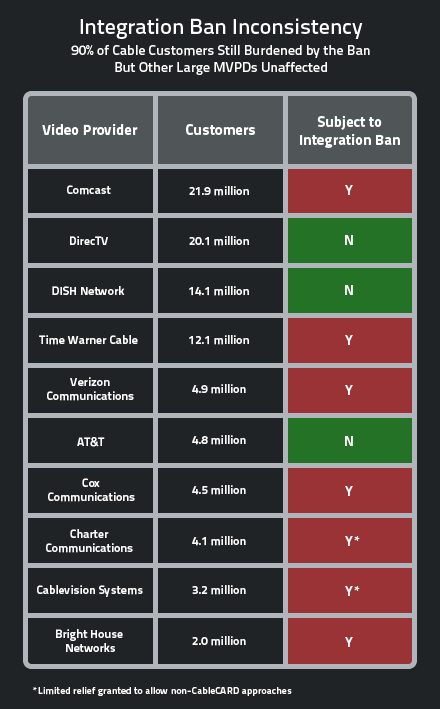Right now, inside your cable set-top box is a CableCARD – a device about the size of a credit card that decrypts the content delivered to your home so that you can receive the channels you subscribe to. The strange thing is that the set-top box itself was designed to perform this exact same function. You have both a set-top box and CableCARD because of an anachronistic, expensive, and unnecessary federal rule requiring cable operators to use CableCARDs for decryption. An article today in Ars Technica talks about this exact issue. The federal rule requiring cable operators, and cable operators alone, to use CableCARDs instead of built-in security in their set-top boxes is called the integration ban. It was adopted in 1998 by the FCC when it implemented the 1996 Telecom Act, even though the Act didn’t require it.
CableCARDs were designed for consumer electronics manufacturers who wanted to build and sell their own set-top boxes at retail outlets and needed a way to decrypt the cable signal. But some were worried that CableCARDs might not work properly in retail devices unless cable companies were forced to use them in their own set-top boxes. As a result, the integration ban was conceived as a way to ensure that CableCARDs worked in retail devices.
Since 2007, when the FCC required cable operators to stop using integrated set-top boxes and put in CableCARDs instead, the integration ban has added over $1 billion in needless costs to subscribers. And on top of the added hardware expense, subscribers also collectively foot the bill for roughly 500 million kilowatt hours consumed by CableCARDs each year. We've argued for years that the integration ban is an unnecessary and wasteful mandate that drives up the cost of equipment and offers little if any consumer benefit.
And to be clear, if the FCC rule is eliminated, customers who want CableCARDs for use in retail CableCARD-enabled devices (like some TiVo boxes) will still be able to get them.
Eliminating the integration ban will reduce costs for consumers, cut set-top box energy consumption, and allow cable providers to compete on a level playing field with the many other video providers in the marketplace who aren't subject to the integration ban. The ban has outlived its purpose. CableCARDS are installed in over 40 million operator-supplied set-top boxes, but only 600,000 cards are installed in third-party devices. What this means is that CableCARDs are working to allow retail devices to decrypt cable signals, but that installing them as “insurance” in cable-owned set-top boxes is unnecessary and wasteful.
If the purpose of the ban – to ensure that CableCARDs work whether in leased or retail devices - ever had merit, today the 40 million-plus cards in operator-supplied boxes provide that assurance. When the FCC adopted the integration ban, cable was the dominant video provider, fledging satellite companies were still getting off the ground, and Internet video wasn't even possible. Since then, cable’s share of the multichannel video marketplace has been on the decline. Satellite and telco video providers today hold well over 40 percent of the traditional pay-TV marketplace, yet only cable is subject to the integration ban – hardly a fair requirement in a rapidly changing marketplace.
Today, video competition is fierce and content is accessible across multiple platforms operating on almost any device with a screen. The marketplace has changed and cable should be freed from obligatory, expensive, and unnecessary rules like the integration ban and be allowed to compete fairly in the dynamic video marketplace.
In the words of the FCC itself in the recently released video competition report, “Today the [set-top box] marketplace is more dynamic than it has ever been offering consumers an unprecedented and growing list of choices to access video content.” The case for eliminating the integration ban is clear, and Congress should act swiftly to promote innovation and recognize a dramatically changed marketplace.
